In Ukraine, several hundred, and perhaps even several thousand, ancient cemeteries, over a hundred or two hundred years old, have been preserved. These places, often unknown to the general public, are witnesses of past eras and hold many stories that remain unexplored and forgotten to this day.
No one remembers who is buried there anymore, and a human foot may not step on some crosses for decades.
At the same time, ancient Ukrainian cemeteries are able to "tell" many stories both about the people who lived here in the past, and about the area itself.
And it is also material evidence of the presence of Ukrainians in those regions of Ukraine, which Russia now calls "historically Russian".
Map of cemeteries and the oldest cross
From 2022, the public organization "Ukraine Incognita" is compiling a map of ancient cemeteries of Ukraine.
They are entered into the database, where the geographical location and condition are described, and they are necessarily photographed.
Now there are more than 850 cemeteries in different regions on the map.
"We did not expect that there would be so many," Roman Malenkov, head of Ukraine Incognita, told the BBC.

Photo author, "Ukraine Incognita"
This association began in 2005 as an online journal of geographers, historians and local history bloggers about little-known places in Ukraine. Later, "Ukraine Incognita" began to conduct tours to such locations and later became a public organization.
One of its projects is "Ancient cemeteries of Ukraine" - recording and preservation of old Ukrainian burials.
Roman Malenkov suggests that there may actually be much more ancient cemeteries in Ukraine than 850 - two or even three thousand. But they still need to be found and described.
"The oldest known cross stands near the village of Zimne in Volyn - XIII century. This is the grave of Klym Hrystynich, a lieutenant of the Ukrainian king Danylo Romanovych," the researcher says.
This cross is mentioned in the record of the "Galician-Volyn Chronicle" about one of the military campaigns against the Poles in 1213: "Then Klym Khrystynich, one of all his [Danyl's] soldiers, was killed, and this is his cross that still stands on the Dry Road ".

The author of the photo is Yuriy Lishchuk
The study of this grave was described in detail by the local historian Yurii Lishchuk.
"This is the cross that we can date. Perhaps there are older ones, but scientists do not have the opportunity to date them, because no epitaphs or other evidence have survived. About everything related to the 16th century. and older, it is very difficult to speak," says Roman Malenkov.
Cossack crosses
As for the 1600s, sometimes historians and volunteers manage to date the Cossack crosses of Khmelnytskyi region according to known historical events that took place in this area.
For example, the Pyatnytskyi cemetery in Kremenets, where the Cossacks of Maxim Kryvonos who stormed the Kremenets Castle in 1648 are buried.
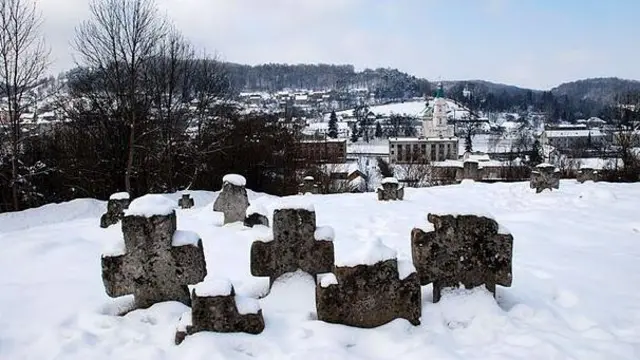
Photo author, "Ukraine Incognita" / Roman Brechko
Or the "Cossack Redoubt" cemetery in the Rivne region - several surviving crosses on the memorial between the villages of Semiduba and Ploska. These are the graves of the Cossacks of Ivan Bohun's regiment, who defended themselves here after the lost Battle of Berestechko in 1651.
However, the absolute majority of known ancient Ukrainian cemeteries, which can be used to make assumptions about dates, belong to a later period - from the end of the 17th century. and until the beginning of the 20th century.
Their characteristic attribute is "Cossack crosses" - sprawling "paw" crosses, which are associated with the paraphernalia of the Order of the Templars.
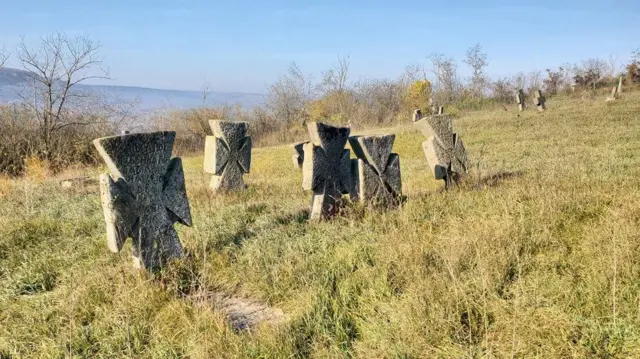
Photo author, "Ukraine Incognita"
"It is most likely that this was facilitated by the entry of the Cossacks into the Order of Christian Knights (Ordre de la Milice chrétienne) during the time of Hetman Pyotr Konashevich-Sagaidachny, because this organization also used the Templar paw cross," writes Anton Drobovych, head of the Ukrainian Institute of National Remembrance.
The same form of the cross can now be seen in the symbols of the Armed Forces of Ukraine and various types of their forces (land, navy, air force), border guards, rescuers, as well as on the coats of arms and flags of several regions (Volyn, Rivne, Poltava, Vinnytsia, Zhytomyr).
At the same time, "Cossack crosses" by themselves do not mean that Cossacks in the classical sense are buried under them.
"Because of these crosses, cemeteries are often called "Cossack", but there you can find graves even from the beginning of the 19th century. Perhaps Cossacks were once buried on them, but later they were the graves of their descendants. However, the form of the "Cossack" crosses was preserved, and this created the Ukrainian tradition of burials," explains Roman Malenkov.
"That's why we call such cemeteries "ancient Ukrainian" or sometimes "Cossack-peasant" necropolises. The main thing is that the Cossack tradition is followed there," he adds.
Crosses and stories
Unknown old graves carry a whole layer of unexplored and unrecorded history.
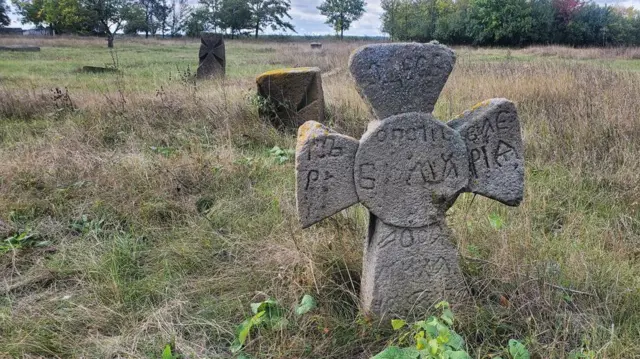
Photo author, "Ukraine Incognita"
Roman Malenkov recalls how "Ukraine Incognita" received a photo of the cemetery from a resident of the village of Kolodiste in the Cherkasy region: "We were amazed by those crosses and the fact that they are in an open area, and not in shingles. They were big, massive crosses, and I had never seen their photos on the Internet before."
They went to this location twice, recorded 45 old stone crosses and about 150 grave slabs, which are already lying horizontally. Probably, there are more crosses and slabs here, but some of them have naturally sunk over time, it is now more difficult to find them.
We decided to investigate one of the largest crosses that remained in this cemetery. There was an epitaph on it, but it was difficult to read due to old age, moss, lichens and mechanical damage.
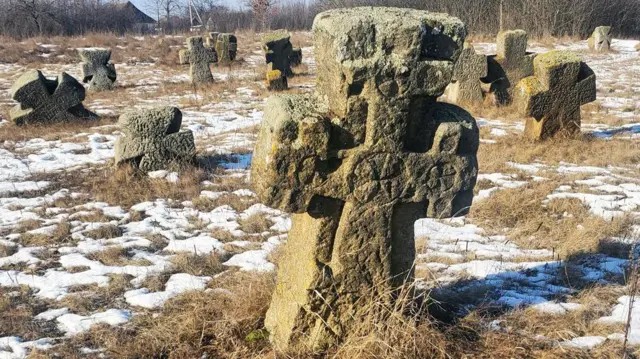
Photo author, "Ukraine Incognita"
Andrii Yarovy, the head of the technical department of "Ukraine Incognita", created a 3D model of the cross with the help of photogrammetry (photographing from all sides), which was then printed, and finally they were able to read the epitaph.
It was found out that a man named Vasyl Kosoblyk is lying in the grave, the year of his death is 1810. He was the "founder" of the local church - that is, the person who financed its construction or arrangement. Actually, the size of the cross also indicates that this is the grave of a wealthy person.
Historian "Ukraine Incognita" Roman Zakharchenko researched the archives of that time and found there references to Vasyl Kosoblyk.
In 1795, he was already written about as a very elderly peasant with a wife who is 30 years younger. And the first son of five children appeared when Vasyl was 40 years old.
Further, there is space for assumptions about the conditions in which Vasyl Kosoblyk lived in the second half of the 17th century. These were the last years of Zaporizhzhya Sich's existence.
"Where was he before 1795? It is doubtful that in this very village, because how could he live in those days for half a century and not have a wife. Where did he get the money? A lot of money, for which he raised and made a rich family, which put such a cross on him after his death. There are many options, but it immediately comes to mind that Vasyl was a Cossack and was in Sich, where Kalnyboloto, the closest town to Kolodisty, had its own smokehouse," says the hypothesis on the "Ukraine Incognita" website.
There is indeed a village of Katerynopil near Kolodisty, whose old name "Kalnyboloto" is mentioned in the name of one of Sichi's kuren and "is reflected in the name of the Kalnybolot hundred of the Korsun regiment"
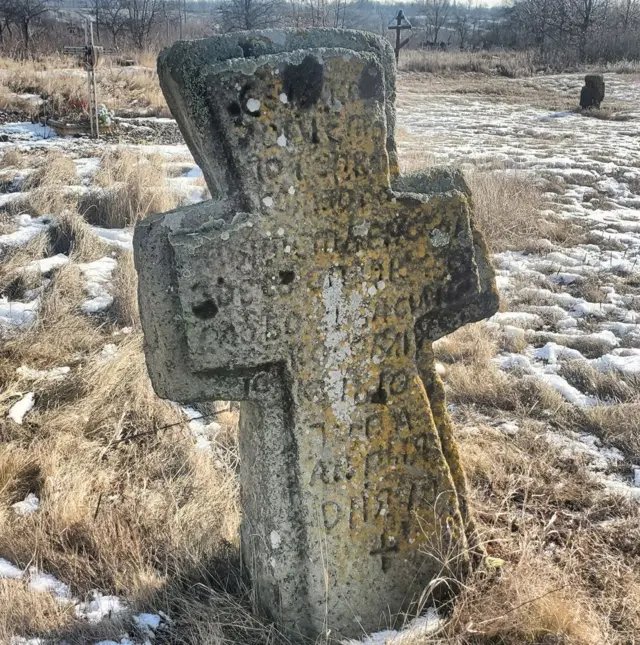
Photo author, "Ukraine Incognita"
"After studying the epitaph on the cross, we probably get out of oblivion the biography of a successful, rich Cossack, Vasyl Kosoblyk, who returned from Sichi with money and started a trade - he began to extract sandstone. And the children were provided so much that they were able to put up a cross, which remained the largest in the cemetery," Roman Malenkov describes the assumption.
"Through one cross, with good historians and researchers, you can find the stories of people who have been forgotten for a long time. And there are actually many such stories," adds Roman Malenkov.
About 50 crosses and 150 large gravestones have been preserved in Kolodistom. And it could have been even more.
"Locals say that in the 1930s, part of the graves were dismantled for building stone, but the rest were saved. Perhaps there were still living relatives of those who lie in the old burial grounds," Roman recounts.
Another case that was remembered by the volunteers of "Ukraine Incognita" is the cross in the village of Lisovody, Khmelnytskyi region.
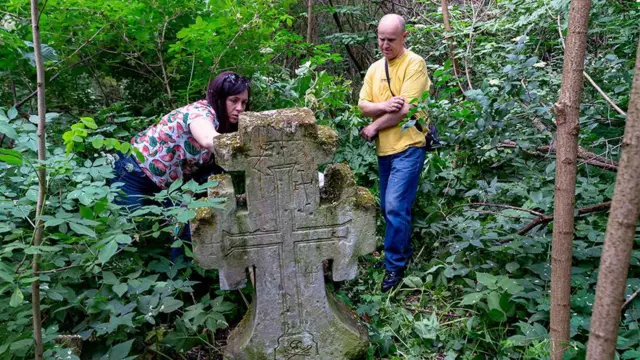
Author of the photo, "Ukraine Incognita"/Dmytro Polyukhovych
It is covered with scratched petroglyph crosses, which were left by people who came to the grave to "strengthen" their prayers (in cave monasteries, such marks are called "graffiti").
On the 3D model of the cross, it was possible to read that a man named Pantilimon Kopytk, who lived 75 years and died in 1860, was buried in the grave.
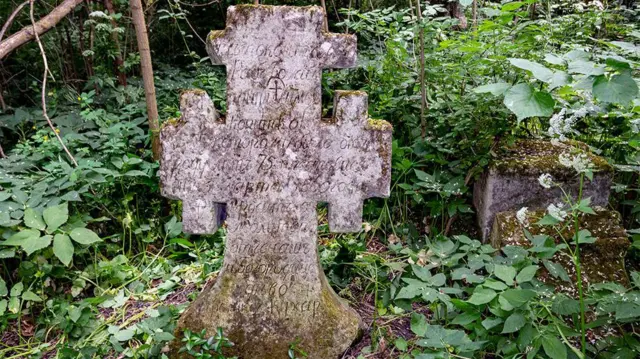
Author of the photo, "Ukraine Incognita"/Dmytro Polyukhovych
"I counted 17 petroglyph crosses on the cross. Moreover... there are pieces of five different types, very interesting and diverse. And it is also interesting why the grave of this peasant was so revered", - says Dmytro Polyukhovych, a local historian and researcher of the Christian Schemnik caves.
Historian Pavlo Nechitaylo also notes the unusual shape of these petroglyphs.
"These are images of small crosses of various shapes carved on different planes of the cross. There are crosses with a semicircular dash, crosses with T-shaped ends of arms and a vertical crossbar, and crosses with triangular extensions at the ends. These crosses are found in Christian rock-cave monuments of Middle Transnistria and have a broad chronology (XII-XVIII centuries)," he explains.
The historian also adds that, taking into account the age of the cross (1860), "these are the latest relatively dated cross-shaped images of this kind in the region and possibly in Ukraine."
It is not known who exactly Pantilimon the Copt was, and why crosses were left on his grave.
"Most likely, here we are talking about the so-called "pilgrim's cross" - the grave of a person who was considered a saint in this area and who was never canonized, is unknown to anyone. But then the locals respected her very much and went to pray near the cross. People could visit this burial decades after Pantilimon the Copt died," says Roman Malenkov.
Shadows of forgotten villages
Old cemeteries preserve the memory not only of the people buried there, but also of whole villages, of which sometimes only the names remain.
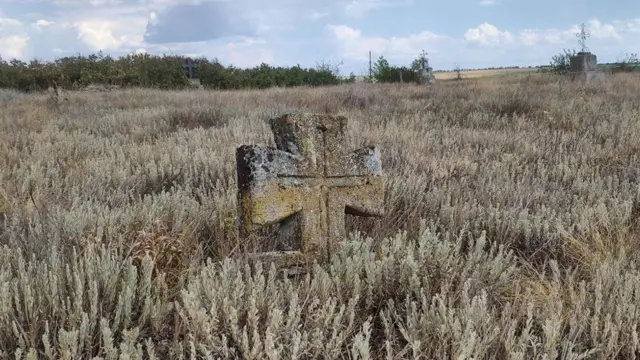
Author of the photo, "Ukraine Incognita"/Olexandr Moiseyev
A friend of the authors of "Ukraine Incognita" Oleksandr Moiseev once sent them photos of old stone crosses, which he accidentally came across in the middle of a field in the Mykolayiv region. There was no settlement there, only a few kilometers to the east is a village called Solonchaky.
On old maps, it turned out that Solonchaks were once called Bilyakovychy, next to which was the village of Maly Adzhigol. It was at this place that the crosses were discovered - no other traces of the farm survived.
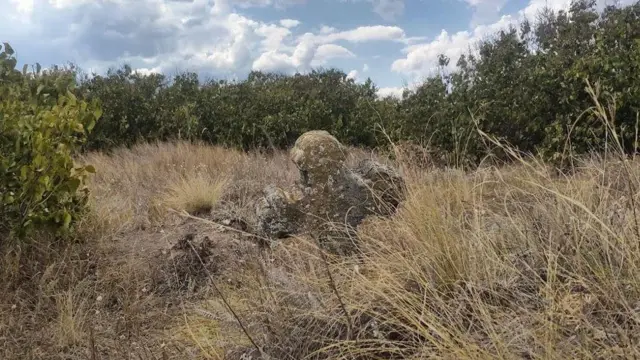
Photo author, Ukraine Incognita"/Olexandr Moiseev
"It was founded by Cossacks who, after the destruction of Sichi, moved to the lands of the Sultan, and then became single peasants. There was a church and a parish school in Maly Azhigol - now, when there are only crosses in the field from it, it's hard to believe," the post of "Ukraine Incognita" reads.
There are seven cases where there is a cemetery, but there are no surrounding villages, only in the Mykolayiv region. And throughout Ukraine, there are many more such "shadows of old settlements".
"For example, in the Rzhishchev district near the village of Baliko-Shuchinka, there is an abandoned cemetery in the forest on the site of the village. Crosses remained in Trakhtemyrov as well - there, some of the old Cossack villages were partially flooded and partially evicted," says Roman Malenkov.
The old cemetery as a memory of such a flooded Cossack settlement and monastery remained on the site of the Trakhtemyriv village of Monastyrok.
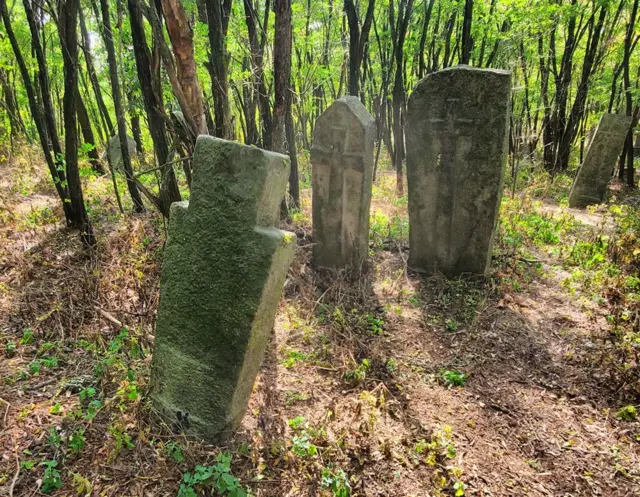
Photo author, "Ukraine Incognita"
Often no one knows about such lost cemeteries at all, they are not protected in any way and are not marked on maps.
"There was a case in the Mykolaiv region when a tractor driver was driving from a field in the evening and ran into an old cemetery where the crosses had already partially sunk into the ground. Took down a dozen crosses. Local activists wrote a complaint to the police. But there they said that there is no crime, because it is not a monument protected by law. It was the cemetery of a defunct village," laments Roman.
Material evidence of Ukrainianness
In addition to the memory of people or disappeared villages, ancient cemeteries also testify to the ancient presence of the Ukrainian population in the regions.
In particular, in the southern regions of Ukraine, which the Kremlin now represents as "historically Russian".
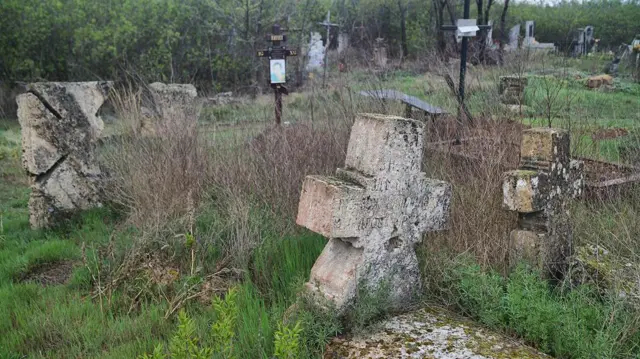
Photo author, "Ukraine Incognita"
Ukrainian historian Olga Yadlovska in the study "Ethnic composition of the rural population of southern Ukraine on the eve of 1917." writes that during the XVIII-XIX centuries. the southern Ukrainian region was really formed as a multi-ethnic region.
And despite the noticeable presence of other nationalities (especially in the cities), including Russians, Jews, Bulgarians, German colonists and others, the majority here were still Ukrainians.
"The most numerous [nation] was the indigenous - Ukrainians, and they made up a significant majority of the entire composition of the Ukrainian provinces," Olha Yadlovska notes.
As Roman Malenkov says, old Ukrainian cemeteries in Odesa, Mykolaiv, Kherson, and Zaporizhzhia regions are direct evidence of this.
"The cemeteries of southern Ukraine are indisputable material proof of the Ukrainianness of the region," he says.
On the "Ukraine Incognita" map, the Ukrainian Black Sea region is indeed covered with dozens of cemetery markers with "paw" crosses, which the organization was able to investigate or at least obtain data about before the start of a full-scale war.

Photo author, "Ukraine Incognita"
Roman Malenkov recalls how in 2015 he got to the village of Zagnitkiv in the north of Odesa near the border with Moldova and saw many old limestone "Cossack crosses" there.
"It was a settlement of Cossacks who once moved from Sichi after its destruction and engaged in limestone mining. Having become quite skilled craftsmen, they made crosses on the graves with carvings, fonts, images of biblical subjects. After that, we began to travel through the south of Ukraine and almost every second village has preserved ancient crosses - Cossacks and their descendants," says Roman.
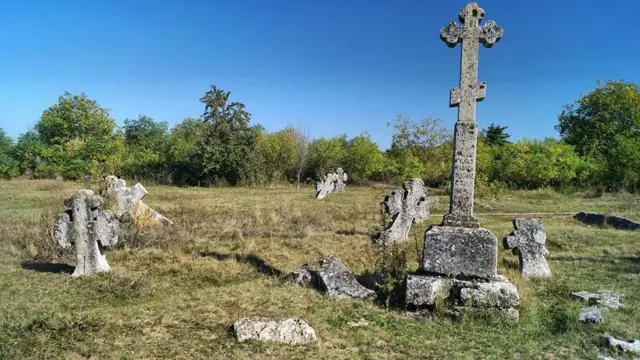
Photo author, "Ukraine Incognita"
As for the east of Ukraine, "Ukraine Incognita" cannot investigate the old cemeteries there because of the fighting.
Although sometimes information and photos about old burials are sent from there by the military - there are mentions of cemeteries near Maryinka, Severodonetsk, and Pokrovsk on the map.
"In these territories in the 18th century there was Kalmius palanka. But it is difficult for us to state how many cemeteries of Cossacks and their descendants remain there. All this still needs to be studied," Roman Malenkov admits.
The Kalmius Palanka is an administrative association of Zaporizhia Cossacks in the basin of the Kalmius River in Donbas, centered on the site of modern Mariupol, where the Domakh fortress was then.
Palanka consisted of dozens of villages, freeholds, farms and winter quarters, on the site of which there are probably the remains of unexplored Cossack burials.
Cemeteries as portals to the past
The vast majority of ancient cemeteries of Ukraine are not recorded and protected by law as monuments.
"Many Ukrainian crosses are unique. They were not a factory product, but a fantasy of the masters. That is why we have such a variety of forms of crosses. Even before the 1920s, there were masters who worked with a chisel and other rather primitive tools, but created amazing products," says Roman Malenkov.
According to him, in other countries such cemeteries are treated "like a treasure".
For example, Armenia was able to include its traditional "khachkar" stone tombstones in the UNESCO heritage. The Balkans managed to do the same with their ancient burials called "stečki", most of which are located in Bosnia and Herzegovina.
"And our ancient cemeteries are not even included in the register of monuments. They are destroyed by tractor drivers, trees fall on them, they become overgrown with thickets and gradually disappear," Roman Malenkov complains.
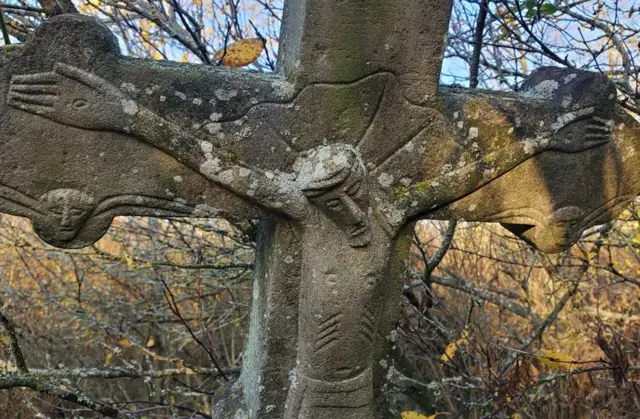
Photo author, "Ukraine Incognita"
The Ministry of Culture says that in fact there are a number of old graves in the State Register of Immovable Monuments of Ukraine. But there is no separate register of cemeteries.
Therefore, "Ukraine Incognita" insists that at least an official list of ancient cemeteries with information about them is needed.
"In some areas of old cemeteries, people may not appear for decades, because everything is overgrown. But that's where the old stone crosses stand. How can anyone find out about them? Even if most of the locals don't know who is buried there, and the generation that knew it has already died, or its last representatives are too old to remember," explains Roman Malenkov.
Another step should be to educate local communities on how to deal with old burial grounds, how to preserve, restore and transform them into cultural spaces.
"These can be very visited objects, such as, for example, a cemetery in the middle of the forest on the site of the Ukrainian village of Stare Brusno in Poland, where tourists go," - notes the head of "Ukraine Incognita".
"Old cemeteries are a kind of "portals" that transport us to past centuries. This is the material thing that remained from our ancestors and that connects us with them, and thus connects Ukrainian history", - sums up Roman Malenkov.

